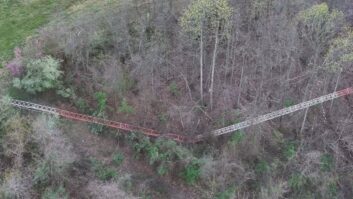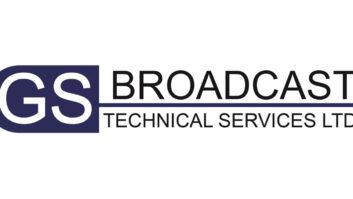
VRT Radio 2’s new newsgathering vehicle sports the station’s logo and colors. All photos courtesy M. Maes.
ANTWERP, Belgium — In January, VRT’s Radio 2 (www.radio2.be) took delivery of new outside broadcast Mini Cooper cars, serving the station’s local programs. Their compact size allows them to operate in urban areas, equipped with the latest technology.
In 2004, the Dutch-language public broadcaster decided to invest in OB vans in addition to the station’s extensive fleet of mobile radio and TV studios to provide live footage for Radio 2’s regional programming. This first generation of its radio vans (Mercedes Vaneo series) had come the end of their useful lives and were replaced this year by the small Mini Cooper cars.

Wim Moortgat, left, and Ward Weis stand next to
the new Radio 2 car. RADIO, VIDEO
Wim Moortgat, of VRT’s technical production team, explained that the new cars serve radio’s ongoing evolution. “Radio is about more than just listening. We have text messages, pictures and video footage — and in addition to the ‘classical’ radio set, we run content on the Web, streaming and TV,” he said. “The first generation of radio cars made use of ISDN via satellite, now we have the Internet via satellite, allowing us to transmit sound and images to the studio.”
As regards concept and design of the new cars, user-friendliness and comfort are key, with tools that allow maximum autonomy for the reporter. The broadcaster’s goal is that the reporters using the cars are acquainted with all of the functionalities and know how to use them.
Moortgat added that the new cars, seven in total (five serving Radio 2’s regional newsrooms, one car for Radio 2’s central services and one for its general radio newsgathering services), have been equipped with video codecs to allow the transmission of video content. The car used by Radio 2’s central services in Brussels has additional video editing equipment onboard for the channel’s online feed.
“Another novelty is that the cars are equipped with Internet and serve as an Internet hub, offering reporters identical tools and the same access they have on their workstations at the regional radio center. Connectivity with the VRT’s corporate network is bidirectional, ensuring the transmission of data and logistics to the van. The reporter also has access to VRT’s i-News newsroom platform, the car is like an expansion of the reporter’sworkplace at the radio station,” said Moortgat.

The reporter’s “mini studio” is located in the backseat of the car.
For connection, VRT’s Research and Innovation department developed a specific transmission tool that automatically switches to satellite, mobile 3G/4G networks or Wi-Fi hotspots, depending on the best available network. “The reporter doesn’t need to choose a transmission technology and only has to switch the satellite on,” said Ward Weis, who is a VRT Radio 2 technician and regular user of the Radio 2 Antwerp car. “The application allows large volume transfers and live broadcasts under the best possible technical conditions.”
Each car is equipped with a gel battery-powered inverter with almost three hours of power and an external mains supply connector.
FEWER CABLES
The main challenge for VRT’s technical team and the engineers of systems integrator Amptec, the firm that handled the integration, cabling and installation of the seven cars, was finding equipment compact enough to fit into the Mini Coopers.
“We thought about the best balance between functionality, weight and power consumption,” said Bart Lamberigts, Amptec project manager. “Our project proposal was based on a DHD console, a Prodys Prontonet IP audio codec, the Victron Multiplus charger/invertor and the C-Com Ka-75 K drive-away satellite antenna.”

The wireless mic equipment, DHD core and satellite
router are integrated into the trunk.
Equipped with a DHD 52/DX four-fader mixing unit, identical to those used in its broadcast studios, VRT simplified the use of the mobile studio for reporters. “The big value of the cars and equipment is the ability to go ‘live,’” said Moortgat. “But at the same time, reporters continue to have the option to record audio content, edit the file on their laptop with Dalet Onecut software and transfer to the studio.”
Live reports are handled with Sennheiser MD 21 and SKM 3072 mics. “The laptops are connected with the console over a USB connection: the console behaves as a USB audio device,” said Lamberigts. “USB is also used for the file ingest, between the handheld recorders and the Onecut editing tool. Fewer cables, more compact and 100 percent reliable,” he said.
The mini-studio, located in the back of the car also includes a Fostex 6301D digital monitor speaker and a laptop. “Ninety-five percent of the monitoring is via headphones,” said Moortgat. The Sennheiser wireless EM 3031 and SR 3054 mic receivers/transmitters, the C-Com satellite router, the DHD core, the Prontonet, a patch panel and connectors are located in the trunk.

The new Radio 2 Mini was used during the industry union strikes in Antwerp protesting against the government’s social spending cutback plans.
HUB
“We chose the Mini because we needed a compact car for all types of assignments — even with the satellite dish on the roof we can park the car in underground parking garages, which wasn’t the case with the Mercedes vans,” said Weis. “It’s amazing how much room you have in such a small car.”
Thanks to their modular configuration and connectivity, the cars are futureproof, added Moortgat. “The Internet hub opens up the possibility for additional features — the satellite has a bandwidth capacity of 2 Mbps, scaleable to 10 Mbps. The dish operates via the Ka Band, resulting in higher speed. The current 2 Mbps (symmetric, bidirectional) is sufficient to transfer basic audio and video content to the studio,” he explained.
“It is also possible to use the Mini as a hub for a full broadcast of a radio show or event, including audio and cameras.”
Moortgat also mentioned VRT’s new mobile radio studios, currently in the testing phase, for outdoor broadcasts and the transmission of programs produced on-site. Since the studio is very small, just one engineer can set it up. “We will mount the studio on a trailer so the Mini can pull it,” he added.
Weis first used the VRT Radio 2 Mini Cooper outside broadcast car during national industry union protests in January, where he covered the events for Radio 2 Antwerp. “Each individual Radio 2 newsroom (Antwerp, Limburg, Brabant, East-Flanders, West-Flanders) decides which assignments will be channeled to the radio car,” he said. “Despite its quite minimalist looks and configuration, the Mini is very pleasant to work with.”
Marc Maes reports on the industry for Radio World from Antwerp, Belgium.











